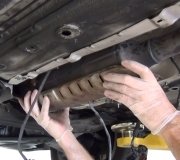Introduction
A catalytic converter is a vital component of your vehicle's exhaust system, and is designed to remove harmful gasses from our atmosphere. This smog device is positioned as part of the engine's exhaust system which can be built into the exhaust manifolds, just behind the exhaust manifolds, or in front of the muffler.
What Goes Wrong
A catalytic converter can fail in one of three ways:
- Catalyst material wears out and loses it's effectiveness
- The internal ceramic structure can overheat and break apart
- Engine oil, antifreeze, or unburned fuel can coat the catalyst preventing its functionality.
Failed Catalytic Converter Symptoms
1. Low Engine Power: An automotive engine depends on a free flowing exhaust system to maintain its power output. If the catalyst material inside the catalytic converter breaks apart or melts it can cause a partial blockage causing poor engine acceleration. There are many stages of this blockage which will vary greatly, but it will usually be noticed under heavy engine load while slowly losing more and more power.
2. Check Engine Light: When a catalytic converter stops working or becomes weak, it will allow increased emissions to be omitted from your car's tail pipe. The oxygen sensors then detect this issue and trigger the check engine light malfunction warning, these are the typical codes presented.
- P0420: Catalyst System Efficiency Below Threshold (Bank 1)
- P0430: Catalyst System Efficiency Below Threshold (Bank 2)
3. Failed Smog Test: Over time the catalyst material inside the converter will loose its effectiveness allowing a downgrade of its ability to converter unspent fuel into spent fuel inside the exhaust system. When it fails, the levels of carbon monoxide (CO), hydrocarbons (HC), and nitrogen oxides (NOx) in the exhaust will increase significantly, resulting in an emissions test failure.
4. Exhaust System Rattling or Whistling Noise: If the internal components of the catalytic converter break apart due to wear or damage, they can become loose and cause a rattling or whistling sound while the engine is running, (Note: This condition is not always associated with low engine power).
5. Engine Misfires (One Bank): On a V8 or V6 engine if a catalytic converter goes bad on one side of the engine, either right or left it can cause an entire bank to give misfire codes.
Example for a V6 Engine:- P0301 – Cylinder 1 Misfire Detected
- P0302 – Cylinder 2 Misfire Detected
- P0303 – Cylinder 3 Misfire Detected
6. Engine Not Starting: It's possible that when the material inside the catalytic converter breaks apart it can completely block the outlet of the exhaust system not allowing air to enter the engine. This blockage can be intermittent and will happen while driving, once the engine stalls it can start back up as the blockage falls away from the outlet until you hit a small bump, which again can be pushed back into the outlet.
Suspect a Bad Catalytic Converter?
If you suspect your catalytic converter is failing based on the symptoms above, you can test the catalytic converter yourself to see if this could potentially be a problem or not. Since the cost of a catalytic converter can be high, it's important to confirm the diagnosis before proceeding with any repairs.
Can a Catalytic Converter Be Internally Cleaned?
A catalytic converter can be cleaned in some cases, but the success of cleaning depends on the underlying problem and the severity of the issue.
Watch the Video!
Please watch this video of the job being done to glean additional helpful information.
Credits
This guide knowledge base was created by the 2CarPros Team, and by Ken Lavacot: Automobile repair shop owner and certified master automobile technician of over 30 years. If you have question or need help please ask one of our experts we are happy to help. Please visit our 2CarPros YouTube Channel for additional car repairs.




